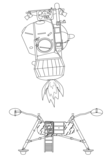 | |
| Manufacturer | Yuzhnoye Design Bureau |
|---|---|
| Country of origin | Soviet Union |
| Used on | LK |
| General characteristics | |
| Height | 2.38 m (7.8 ft)[1] |
| Diameter | 1.72 m (5.6 ft)[1] |
| Gross mass | 2,950 kg (6,500 lb)[1] |
| Propellant mass | 2,390 kg (5,270 lb)[1] |
| Empty mass | 525 kg (1,157 lb)[1] |
| Launch history | |
| Status | Retired |
| Total launches | 0a[2] |
| Successes (stage only) | 0 |
| Failed | 0 |
| Blok E[3] | |
| Powered by | 11D410 engine cluster Consisting of: 1x 11D411 1x 11D412 4x Vernier Thrusters |
| Maximum thrust | 20.1 kN (4,500 lbf) (11D411 at 100% Thrust or 11D412) 8.4 kN (1,900 lbf) (11D411 at minimum Throttle) |
| Specific impulse | 315 s (3.09 km/s) (11D411) 285 s (2.79 km/s) (11D411 at minimum Thrust) 312 s (3.06 km/s) (11D412) |
| Burn time | 400 seconds Full Thrust +100 seconds throttled (11D411) 400 seconds (11D412) |
| Propellant | UDMH/N2O4[4] |
Blok E (or Block E) is the propulsion unit of Soviet lunar module LK, developed in the 1960s by Yuzhnoye Design Bureau as a part of the human lunar landing program.[3]
Blok E was designed to soft land the LK on the surface of the Moon after orbital velocity was cancelled by Blok D. Later the same stage would fire for the second time for the liftoff and ascent from the Moon to rendezvous with the orbiting Soyuz 7K-LOK.[5][6] Blok E used RD-858 (or 11D411),[7] which has one nozzle and is deeply throttleable (from 2050 kg to 858 kg of thrust),[8] as the primary engine. The backup engine was RD-859 (or 11D412),[7] which has two nozzles.
Together, the two engines formed the propulsion system designated 11D410.[3] Both engines burned a mix of unsymmetrical dimethyl hydrazine and nitrogen tetroxide. The hypergolic propellant components guaranteed their easy storage during a lunar expedition lasting at least 11 or 12 days.
The engines were equipped with clam-shell doors to prevent damaging it while staying on the surface of the Moon. There were four additional vernier engines placed between main and backup engine nozzles. Additionally to the main engine, the backup engine and the verniers, the stage was equipped with eight low-thrust reaction control thrusters feeding off a common propellant reserve.[9] These thrusters had been provided by OKB-300, the Stepanov Aviation Bureau.[10]
| 11D410 | |||||
|---|---|---|---|---|---|

| |||||
| RD-858 / 11D411 | RD-859 / 11D412 | ||||
| Designed | 1964 | ||||
| Propellant | N2O4/UDMH | ||||
| Mixture Ratio | 2.03 at 100% Thrust 1.6 fully throttled |
1.6 | |||
| Engine cycles | Open Gas-generator cycle | ||||
| Pumps | 1 | ||||
| Combustion chambers | 1 | 2 | |||
| Restarts | 2 | ||||
| Dry mass | 53 kg (117 lb) | 57 kg (126 lb) | |||
| TWR | 38.68 (Full thrust) | 35.88 | |||
| Mass flow | 6.5–3.0 kg/s (14.3–6.6 lb/s) depending on throttle |
6.6 kg/s (15 lb/s) | |||
YouTube Encyclopedic
-
1/2Views:6 6942 403
-
BLOKTOPIA 🚨 ULTIMA OCCASIONE PER INVESTIRE ?! | NEWS IMPORTANTI PER [BLOK] e il METAVERSO!!
-
CERAMAH TERBARU 2023 USTAZAH MUMPUNI HANDAYAYEKTI DUSUN III BLOK E DESA SUMBERJAYA.
Transcription
See also
- N-1 – original launch vehicle for which this stage was developed
References
- ^ a b c d e S. N. Konyukhova (2000). Ракеты и космические аппараты конструкторского бюро "Южное" [Rockets and spacecraft design bureau "Yuzhnoye"]. rvsn.ruzhany.info (in Russian). Archived from the original on 25 July 2021.
- ^ "Die russische Mondrakete N-1 (in German)".
- ^ a b c "The many lives of the Soviet lunar landing engine". www.russianspaceweb.com.
- ^ "LK". www.astronautix.com. Archived from the original on August 20, 2016.
- ^ "LK spacecraft and Block E". Russianspaceweb.com. Archived from the original on 2013-12-30. Retrieved 2013-12-15.
- ^ "Liquid propellant propulsion systems, Yuzhnoe Design Bureau". yuzhnoe.com. Archived from the original on 2014-07-14. Retrieved 2014-07-10.
- ^ a b "LK (L3, T2K)". space.skyrocket.de.
- ^ "RD-858". Astronautix.com. Archived from the original on 2016-03-26. Retrieved 2016-03-18.
- ^ Harvey, Brian (17 August 2007). Soviet and Russian Lunar Exploration. Springer Science & Business Media. pp. 143–144. ISBN 978-0387739762.
- ^ "Stepanov bureau". astronautix.com. Retrieved 24 August 2022.
Notes
- a.^ Blok E was part of the N1-L3 lunar expeditionary complex, which was supposed to be launched on the rocket with the same name. As the N1 did not finish development, only dummy stages were launched on the third and fourth launch (serial 6L and 7L).

